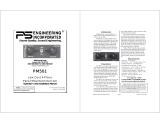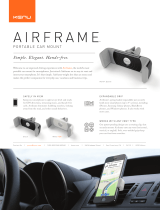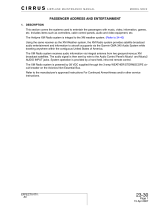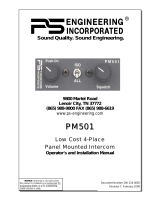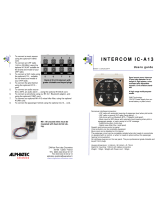
Page 4
200-193-0005 Rev. 9, May 2015
The PM3000 has a specially designed power supply to
reduce conducted electrical noise on the power bus of
the aircraft by at least 50dB. Although this is a very
large amount of attenuation, it does not eliminate all
noise when the amount is excessive. There must be at
least 13.75 Volts DC present at the PM3000 for the
power supply to work within its optimum regulation.
Otherwise, it will not be able to attenuate noise proper-
ly.
Shielding can protect the system from radiated noise
(rotating beacon, electric gyros, switching power sup-
plies, etc.). However, installation combinations can
occur where minor interference is possible. The
PM3000 was designed in an interference -protected
chassis and has internal filter capacitors on all input
lines.
Ground loop noise occurs when there are two different
return paths for the same signal, such as airframe and
ground return wire. Large cyclic loads such as strobes,
inverters, etc., can inject audible signals onto the air-
frame return path. Follow the wiring diagram very
carefully to help insure a minimum of ground loop
potential. Radiated signals can be a factor when low
level microphone signals are bundled with current car-
rying power wires. Keep these cables separated.
Insulating washers are required on all microphone and
headphone jacks to isolate them from aircraft ground.
The use of a conductor instead of a shield for ground
return eliminates these ground loop paths.
2.4.2 Power & Dimmer
The PM3000 series was designed to work with 12.8 to
27.5 volt DC negative ground systems. The PM3000
must be externally protected with a one ampere (1A)
circuit breaker or fuse.
The 11931A & 11933A has Dimmer Control - Pin 5
connects to aircraft dimmer bus. The Power/Xmit LED
will varying lighting conditions with dimmer control.
If pin 5 is not connected the LED will be full bright.
The 11931A and 11933A is shipped for 14 VDC dim-
mer systems. For a 28 VDC aircraft dimmer system,
open the PM3000 case and remove the Jumper J2.
2.4.3 Unswitched Audio Input
The PM3000, P/N 11931A & 11933A have two un-
switched audio inputs available for 500Ω aviation au-
dio sources. Pin 17 is Unswitched #1, and is also pro-
vided to the pilot in Fail-Safe Mode. Unswitched #2
input is Pin 4.
2.4.4 Sidetone
The PM3000 can be modified to produce sidetone
(hearing your voice during radio transmission), if the
aircraft radios do not produce it. Contact the PS Engi-
neering factory for details.
2.4.5 Entertainment Input
Stereo entertainment devices can be connected to the
PM3000. Install ⅛" stereo jacks in a convenient loca-
tion to connect the entertainment devices into the sys-
tem. PM3000, part number 11931A has a single enter-
tainment input. The part number 11932 will accom-
modate two inputs, one for the crew, and another sepa-
rate input that feeds the 4 passengers in CREW mode.
It is possible to use only one entertainment device to
provide music for both inputs in the 11932 system by
connecting the output of the entertainment device in
parallel to both the Music #1 and Music #2 inputs. We
highly recommend, however, that you install a switch
between the entertainment device and Music #1. This
will give the pilot and copilot the ability to switch off
music while in the CREW mode.
The music device will automatically mute when the
ICS or aircraft radio becomes active. The Soft Mute™
feature slowly returns the music to full volume when
the activity ceases. Pressing the Mute disable switch
(located on the squelch control) in will inhibit this fea-
ture. Press again to reactivate SoftMute. Music #2
will never be muted during conversation and is heard
only by the passengers while the intercom is in the
Crew mode.
2.4.6 Passenger Volume Adjustment
The volume knob only controls pilot and copilot inter-
com volume. The PM3000 has adjustments for passen-
ger volume control. These are accessed through the
left side of the unit (viewed from the front). There is a
separate volume control for the left and right channels.
The left adjustment is toward the front, and clockwise
adjustment reduces passenger volume.
2.4.7 Internal Recorder (11933A, 11934 only)
PM3000 part number 11933A and 11934 have an in-
ternal recorder that stores recent incoming radio mes-
sages. A 3.5 mm jack is provided on the rear of the
intercom unit to interface this function. Install a mo-
mentary, normally open (NO), switch in a location
convenient to the pilot, and wire to the 3.5 mm plug
(included) across the tip and sleeve contacts. Closing
this switch will activate the playback. A low-current
rated switch is recommended.
2.4.8 Monaural installations
The PM3000 can be installed as a monaural intercom.
Connect the RIGHT channel to the headsets (this con-
Use only low level output of the entertainment devices
to connect to the PM3000. Maximum signal level on
the input is 2-volts peak-to-peak.
DO NOT USE CAR SPEAKER
OUTPUT LEVELS.
This will cause internal damage.












